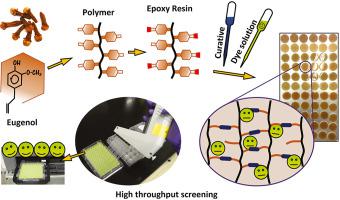Polymer ( IF 4.6 ) Pub Date : 2021-09-15 , DOI: 10.1016/j.polymer.2021.124191 Deep J. Kalita 1 , Ihor Tarnavchyk 1 , Bret J. Chisholm 1 , Dean C. Webster 1

|
A novel vinyl ether monomer from eugenol, 2-eugenoloxyvinyl ether (EEVE), was synthesized and used as a building block for polymeric epoxy resins. The EEVE monomer was polymerized via cationic polymerization of the vinyl ether group leaving the allylic functionality of eugenol available for further epoxidation. Epoxidized poly(EEVE) resins varying in levels of epoxidation (epoxy equivalent weights from 360 to 870 g/eq) were produced and cured with twelve amine curatives at ambient and elevated temperatures for different time intervals to evaluate and optimize the curing regime. The cured coatings were screened with high throughput dye extraction and “conventional” coating testing methods and compared to coatings produced from diglycidyl ether of bisphenol-A (DGEBA). Results showed that coatings derived from epoxidized poly(EEVE) [Epoly(EEVE)] can be tuned from soft and elastic with hardness <50 GPa and glass transition temperatures (Tgs) < 20 °C to hard and brittle with hardness >500 GPa and Tgs > 60 °C by varying the extent of epoxidation and the nature of curative, whereas DGEBA resulted in hard and brittle coatings irrespective of the type of curative used in the study. Compared to DGEBA resin, coatings with similar or higher crosslink densities and hardness were obtained from Epoly(EEVE) resins with >50% epoxidation of EEVE moieties using the same curative and curing regime. These partially biobased epoxy compounds derived from eugenol have the potential to be competitive with petroleum-based DGEBA resins in coatings applications.
中文翻译:

来自丁香酚的新型生物基环氧树脂作为 BPA 环氧树脂的替代品和固化涂层的高通量筛选
合成了一种来自丁香酚的新型乙烯基醚单体,即 2-丁香酚氧基乙烯基醚 (EEVE),并将其用作聚合物环氧树脂的结构单元。EEVE 单体通过乙烯基醚基团的阳离子聚合而聚合,留下丁香酚的烯丙基官能团可用于进一步环氧化。生产环氧化程度不同的环氧化聚 (EEVE) 树脂(环氧当量从 360 到 870 g/eq),并用十二种胺固化剂在环境和高温下固化不同的时间间隔,以评估和优化固化方案。固化的涂层通过高通量染料提取和“传统”涂层测试方法进行筛选,并与由双酚 A 的二缩水甘油醚 (DGEBA) 生产的涂层进行比较。g s) < 20 °C 至硬且脆,硬度 >500 GPa 和 T g s > 60 °C 通过改变环氧化程度和固化剂的性质,而 DGEBA 导致涂层硬而脆,与固化剂的类型无关研究中使用。与 DGEBA 树脂相比,使用相同的固化剂和固化方案,从 Epoly(EEVE) 树脂获得具有相似或更高交联密度和硬度的涂层,其中 EEVE 部分的环氧化超过 50%。这些源自丁香酚的部分生物基环氧化合物有可能在涂料应用中与石油基 DGEBA 树脂竞争。



























 京公网安备 11010802027423号
京公网安备 11010802027423号